Home » Jazz Articles » Live Review » Hong Kong International Jazz Festival, Days 4-6, Septemb...
Hong Kong International Jazz Festival, Days 4-6, September 28-30, 2011

Hong Kong International Jazz Festival
Hong Kong
September 25-October 2, 2011
The 2011 Hong Kong International Jazz Festival offered up over forty groups from 24 countries—a big jump from the eight bands that made up the first edition of HKIJF in 2008. Apart from the music, there was a series of activities and talks covering a wide range of topics. Workshops focused on improvisation, creativity for children, vocal improvisation and interaction through rhythm. The "Dialogues with Jazz" talks addressed various issues concerning jazz in South East Asia, as well as historical overviews of jazz in the United States and Central Europe. One of the most interesting non-musical offerings was the photographic exhibition entitled "Jam Session: America's Jazz Ambassadors Embrace the World," though oddly, it finished before a single note of the 2011 Hong Kong International Jazz Festival had sounded.
Featuring 55 photographs, the exhibition portrayed many of jazz's historic figures on State Department-sponsored world tours from the 1950s to the 1970s, and ran from September 13-23 before relocating to Macau, thereby missing the HKIJF by a couple of days. Odd timing perhaps, but the reason for the exhibition's premature departure was simple enough, as Naeema Whatley, Cultural Unit Chief for the U.S. Consulate General in Hong Kong explained: "There's no space available. The photos need specially acclimatized environments and to find a suitable space in Hong Kong you need to book a year, a year-and -a-half in advance."
 Hong Kong at Night
Hong Kong at NightSpace is definitely at a premium in Hong Kong, one of the most densely populated cities in the world. The thinness of many of the buildings—which seem like they've been sliced in half lengthwise—is often surprising. People's apartments, street eateries, shops and many hotel rooms are barely two or three meters wide. Perhaps it would have been more logical to start the exhibition in Macau and shift it down to Hong Kong to coincide with the HKIJF. Then again, maybe there's no space in Macau either, due to all the casinos cluttering the place up.
The single concert on the fourth day was Blanca's Songs, a French jazz quartet fronted by Blanca Gallice and augmented by a four-piece string section of local musicians. The concert was relocated from the intimate setting of Vibes, to the ballroom of the Mira hotel, due to fear of the arrival of Typhoon Nesat, which after leaving 39 dead in the Philippines, was gathering pace and heading towards the city. As it turned out, the move was probably a good one artistically speaking too, as the ballroom was acoustically better-suited to the quite intimate torch songs. It was however, trumpeter Freddie Hubbard's "Mr. Clean" which opened the set. Trumpeter Florent Briquet, pianist Benjamin Rando, electric bassist Simon Taileu, and drummer Cedric Bec gave an energized, hard-grooving rendition of this hard bop classic, before strings and Galice took their places on the stage.
The romance, blues and lyricism of the French songbook make it every bit as suited to jazz interpretations as its more famous American counterpart, and the combination of Gallice's seductive Gallic delivery and the quartet's swinging jazz aesthetic bathed classic French popular songs in a new light. Gallice's ability to make songs written half a century ago or more sound contemporary, and to blend them convincingly with recent pop songs—both French and American—spoke volumes about her vocal and arranging skills. The sparing use of strings lent their interjections weight, and underlined that this was a jazz band first and foremost.
 Bianca Gallice
Bianca GalliceGallice's renditions of the songs of singer/songwriters such as Claude Nougaro, Jacques Brel, Michel Legrand, Leo Chauliac and Charles Trenet, were clearly heartfelt. She also sang several numbers in English, Coolio's "Gangsta's Paradise," and Irving Berlin's pop hit from 1929, "Puttin on the Ritz"—a hit for clarinetist/bandleader Benny Goodman a decade later—though these were less effective vehicles for her voice. However, her take in English on the Red Evans/David A. Mann tune "No Moon at All" carried a sensual allure reminiscent of singer Julie London.
The singer impressed on the slow burning "Dansez sur Moi," which shifted up a gear in intensity with a fine bop-ish solo from Briquet. Subtly employed strings lifted "Je Ne Veux Pas Travailler," with a lovely walking bass mid-section, colored by extended piano and trumpet solos. Pianist Rando and trumpeter Briquet impressed throughout the concert, and although they enjoyed less of the spotlight, so too did the buoyant rhythm section. Strings—directed by Briquet— also brought velvety warmth to "Que rest-a-t-il de nos amor?" The swinging "Sing Sing" and "Ne Me Quitter Pas" provided other concert highlights. One pleasing aspect of the evening was the impeccable behavior of the crowd, who gave its undivided attention to the music. A current French pop hit fitted snuggly with the more vintage material. The stylistic thread that Gallice spun, uniting 80 years of popular song through a potion of jazz and French chanson, made for an original and highly enjoyable concert.
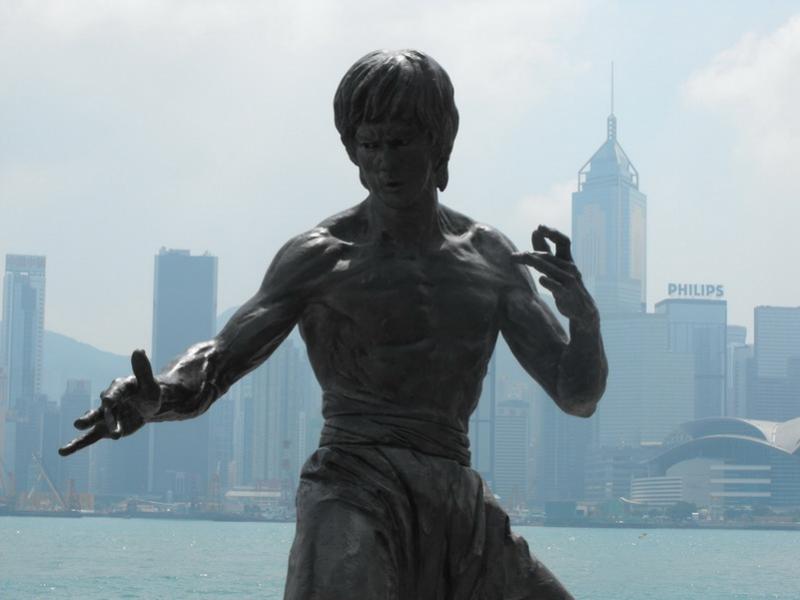 Statue of Bruce Lee
Statue of Bruce LeeAt 4.30 am, Typhoon Nesat was declared a Force 8 storm and Hong Kong battened down the hatches. Government offices, schools, museums and most shops closed. Flights into the city were cancelled or redirected. Ferry and bus services were suspended, and even the stock exchange had a rare day off. Windows were taped up and the streets of Hong Kong were largely deserted as people stayed indoors. The famous Avenue of Stars—a pathway by Victoria Harbor dedicated to Hong Kong's film idols—saw only tourists and the brave, as the wind whipped and rain fell ominously. The statue of Bruce Lee cut an even more defiant, heroic figure in the conditions.
By the time the typhoon had passed and the danger had been downgraded to level three, 12 hours later, the typhoon had left its mark. Hundreds of trees were uprooted, scaffolding was felled, and anchor chains were snapped, pushing two of the huge barge cranes ashore. In a Kafkaesque scene, the limbs of broken umbrellas—slim defense against 120 kph gusts of wind— protruded from every street bin, and lay shattered all over the place, as though some strange culling had taken place.
Thankfully, the double-header concert at the Hong Kong City Hall went ahead without a hitch. First up was the Dainius Pulauskas Group, veterans of the Lithuanian jazz scene. Pianist/keyboardist Pulauskas is without a doubt, one of the most interesting composers at the fusion end of European jazz, and has been at the helm of this sextet for seventeen years. A front line of trumpeter Valerijus Ramoska, tenor saxophonist Rimantas Brazaitis, and alto/soprano saxophonist Kestutis Vaiginis brought a big band feel to the leader's imaginative arrangements, while bassist Leonid Sinkarenko's funk lines and drummer Linas Buda's more rock-informed beats brought extra dimensions to the rhythms.
 Dainius Pulauskas Group
Dainius Pulauskas GroupA vibrant and absorbing set was based largely on material from Mixtum Compositum. (DS 6, 2010) At times the melodies, shifting dynamics and wide—ranging sonic textures evoked keyboardist/composer Joe Zawinul's Zawinul Syndicate. Where the Dainius Pulauskas Group differs chiefly is in its more muscular brass approach, and its more direct rhythmic pulse, seen to best effect on the powerful "Chiconora." A mid-section synthesizer interlude, with classical overtones, provided one of the evening's rare moments of Pulauskas unaccompanied. Whether on synthesizer or piano, Pulauskas' measured improvisations flowed naturally, always telling a tale which captured the attention.
Pulauskas's knack of diverting the music from the expected course lent the music an edge. The melodic "Luxor" was a case in point, starting life with unison lines in the brass, shifting to an atmospheric Chinese interlude, before segueing into a lyrical synthesizer segment over a constant groove. Pulauskas clearly recognizes the strengths of his ensemble, and plenty of room was afforded trumpet and saxophones to stretch out, as the leader directed proceedings from his keys.
Muted trumpet and gently swirling synthesizer created an entirely different mood on the intro to the elegant "Safaga." A short burst of bluesy piano provided nice contrast in a piece whose spacey synthesizer ambience evoked memories of William Orbit's electronic/ambient soundscapes. Jazz, however, lies at the core of Pulauskas's music and "Ex Improviso" was a straight-ahead number whose double-time workout was spurred by trumpeter Ramoska and Vaiginis, on soprano. By contrast, the dark-hued brass tones and pounding bass rhythm of the epic "Machine Shop" rivaled the intensity of Belgian big band mavericks, Flat Earth Society. A brief alto and drum exchange led into a solo bass segment, which succeeded in redirecting the number, with Sinkarenko at the heart of the rousing ensemble voice.
The closing number, "White," featured a delightful, almost hymnal trumpet intro, before giving way to Pulauskas on piano. His most extended solo of the evening led into anthemic, unison brass riffs and a rousing end to a wonderful performance. The Dainius Palauskas Group is a unique sextet whose mixture of melody and muscle, lyricism and the unexpected, places it firmly at the forefront of progressive European jazz-fusion.
 Emil Viklicky
Emil ViklickyFrom Lithuania to the Czech Republic, and the piano trio of Czech jazz veteran Emil Viklicky. Since the 1970's Viklicky has forged a singular path, plying straight- Emil Viklicky ahead jazz and composing music for film. What makes Viklicky stand out, however, has been his adaptation of Moravian folk music to jazz. After the lively opener, "Adventure in Black and Yellow"—inspired by Spanish painter Juan Miro—the guts of an excellent set showcased the pianist's decades-long fascination for these beautiful, slightly melancholic folk melodies.
The gentle Moravian folk melodies given a jazz twist evoked the highly influential Swedish jazz pianist Jan Johansson, particularly on "Oh Love, Oh Love" and "Desire" Johansson's treatment of Swedish folk songs in a series of recordings with bassist Georg Riedel in the early 1960s set something of a precedent in European jazz. The album Jazz på Svenska (Heptagon, 1964) has sold over 400,000 copies and been a source of inspiration for a host of modern jazz pianists including the late Esbjorn Svensson, Tord Gustavsen and Andreas Ulvo. Whilst Viklicky acknowledges the precedent of Johansson, his own inspiration is drawn from 19th century Czech composer Leos Janacek, who brought Moravian folk melodies into classical music. For those curious to learn more, check out Victor Verney's All About Jazz interview with Viklicky .
Bassist Petr Dvorsky and outstanding drummer Cyril Zelenak were equal partners in a performance characterized by intuitive interplay. The dialogue between Viklicky was Zelenak was often exhilarating to watch. Viklicky also displayed his refinement as an accompanist, offering deft and telling support to Dvorsky's melodic solos. The bassist—though less exclamatory than his dynamic partners—was the fulcrum and anchor of the trio, and provided plenty of his own subtle colors to the arrangements in the ample space afforded him.
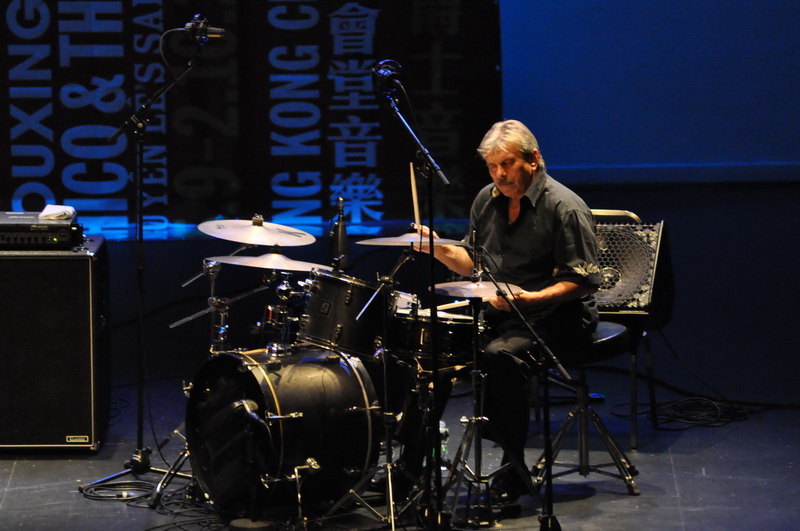 Cyril Zelenak
Cyril ZelenakViklicky is heavily inspired by the romanticism of pianist Bill Evans, though a gutsier blues streak raised its head at times, notably on (loosely translated from the Czech) "Away with the Water," "Aspen Leaf" and "Desire," Moravian tunes where Viklicky's fondness for pianist Wynton Kelly emerged. This latter tune showed the inner workings of the trio on a slower number. Zelenak on brushes initially, displayed finesse every bit as captivating as his more robust drumming. Viklicky has also recorded classical music for close to 30 years, and traces of Czech pianist/composer Antonin Dvořák—himself a fan of Moravian idioms—and Hungarian pianist/composer Béla Bartók suggested themselves in Viklicky's absorbing playing.
Two more Moravian tunes followed, ebbing and flowing, with Zelenak providing what may be the most thrilling drum solo of the festival. A chamber elegance characterized "Forlorn Beech Tree," a hybrid of two compositions which moved sharply from melancholy to a more aggressive mood as the music recalled Czechoslovakia's defense against French General Napoleon Bonaparte's army in dramatic style. The encore, Viklikcy's "Highlands, Lowlands," provided one final taste of the simple but seductive Moravian folk-inspired melodies, and another exciting exchange between the pianist and Zenelak, which steamed up the windows. The intensity diminished gradually, with the trio returning to, and signing off with the original melody, and thus crowning a most memorable concert.
Day six threw up two greatly contrasting, but equally absorbing concerts. First up was Norwegian trio In The Country. Hong Kong was one leg of an Asian tour with stops at jazz festivals in China, Taiwan and Mongolia, in support of the group's fourth CD (and first live release) Sounds and Sights (Rune Grammafon, 2011). Devotees of mainstream American jazz may have been disappointed, but to those with an open mind, the rather special sonic world which pianist Morten Qvenild, bassist Roger Arntzen and drummer Pål Hausken created in the City Hall offered stark beauty in abundance.
A delicate vibes, bass and piano intro of classical hue announced the set opener, "W.A.R.M." The song's memorable melody became gradually suppressed by tumbling drums and rising trio intensity, only to dissolve in a flurry of crashing cymbals and dissonance. A somber, minimalist piano segment punctuated by Hausken's bells and small, suspended cymbals gathered form and power, without altering the pace greatly. But when climax seemed imminent, the intensity waned, leading into the song's beautiful coda, with all three musicians joining in vocal harmony as peaceful as a contented sigh.
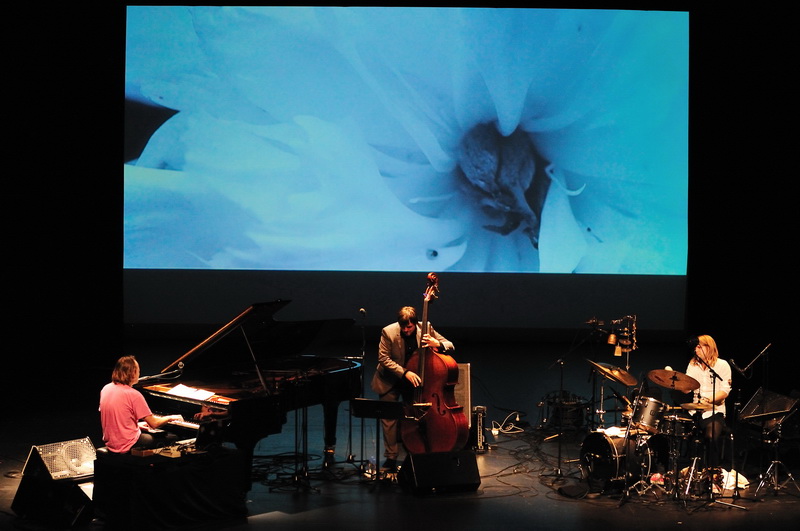 In The Country, from left: Morten Qvenild, Roger Arntzen, Pål Hausken
In The Country, from left: Morten Qvenild, Roger Arntzen, Pål HauskenThe title track from Whiteout (Rune Grammafon, 2009) alternated between the gentle classical/folk-tinged melody and sudden explosions of sound. Qvenild's extended, racing piano improvisation had an elegiac power and grace reminiscent of pianist Keith Jarrett, and eventually steered the trio back into the comforting port of the beautiful melody and restful groove of the beginning.
As a backdrop to the music, a screen showed moving images of nature: a gently flowing river, a bee feeding on a flower's pollen, reeds moving slightly in the breeze, trees, and a fox. The restful quality of the images contrasted with the more dramatic musical segments, and was part of a very careful constructed whole, with the smallest musical detail framed by silence. Nevertheless, improvisation flourished throughout. In this sense, In The Country share a regard for minimalism in some ways comparable to pianist Nik Bärtsch's Ronin, where the tiniest percussive sound assumes great importance. Nevertheless, for all the attention to detail, improvisation flourished throughout.
This adherence to subtle textures and moods also sets In The Country apart from Esbjorn Svensson, with whom the trio was often compared when it emerged with This Was the Pace of My Heartbeat (Rune Grammafon, 2005). The increasing space In The Country gives to vocals also marks them out from other piano trios, though Dire Straits' "Brothers in Arms"—the trio's first non-original—was an instrumental which was fairly faithful to guitarist Mark Knopfler's yearning melody, either side of a tumultuous wall of sound.
The set closer grew from fractured beginnings, with bass assuming a central role amid the whispering, rattling percussion and piano abstractions. From Qvenild's stabbing chords a groove unfolded, led by Arntzen's driving ostinato. Piano and drums drove the music towards the anticipated resolution, but the trio's energy suddenly dissipated, and a quiet melody led it across the finishing line. After the show, the band's CDs were snaffled up in the blink of an eye, which said everything about the impact of In The Country's music on the Hong Kong audience.
Going from the brilliant but painstaking architecture of In The Country's sonic edifice, the joyous, uninhibited improvisations of singer Maria Joao and pianist Mário Laginha was like stepping out of a Cathedral and arriving slap bang in a street carnival. João and Laginha have been performing together as a duo or in quintet form since 1983 and the empathy between the two was clearly evident. So, too, was the enthusiasm which the duo exuded, and the delight they took in performing. The underlying sense that they were playing for and with each other—as much as they were for the audience—was central to the charm their music worked.
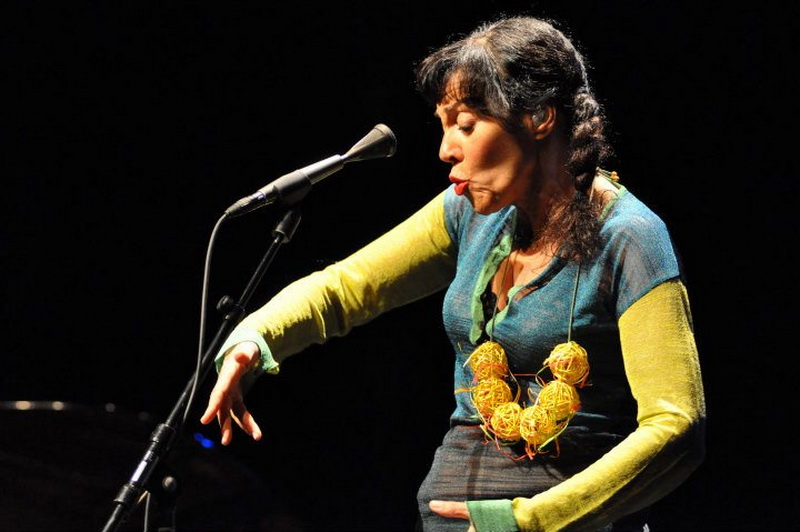 Maria João
Maria João Dressed in bright, parrot green, blue and yellow, her hair in pigtails, and sporting bright red lipstick and a healthy rouge, João's slightly clownish, playful stage persona was a delightful extension of her rainbow voice. Her physical theater, however, shared something of the gift for communicating thoughts and emotions perfected by mime great Marcel Marceau. The performance opened with the moving ballad "Parrots and Lions," from Tralha (Universal Music, 2004), and the audience was rapt from the first note. Laginha's beautiful melody and João's hushed vocals created a dreamlike atmosphere, and Joao hinted at her remarkable five-octave vocal range.
"Goodbye Pork Pie Hat" was João's tribute to singer/songwriter Joni Mitchell, whose lyrics illuminated bassist/composer Charles Mingus's elegy to saxophonist Lester Young. The duo's original compositions provided the most challenging music, however, and the greatest reward. On "Preto E Branco" Joao's lightening fast improvisations of a classical vein segued into an earthier language which reflected her Portuguese/Mozambique heritage. And if not quite such a colorful bird as Joao, Linginha's own voice was certainly a marvel, and his command of musical idioms from classical to jazz, and from boogie woogie to blues equally captivating.
Over a slow, insistent blues vamp, João's vocal/improvisation sung in the Shangana language of Maputo evoked a series of characters relating "can-you-believe-it?" stories. The spirit of her African ancestors was raised in a spellbinding improvisation which could be felt in the guts. João has a lot of the African storytelling tradition herself, and her song intros and asides were humorous and revealing at once. Another extremely delicate ballad, "Cair do Ceu"—this time sung in Portuguese—was achingly beautifully and would have brought tears to the eyes of a Triad executioner.
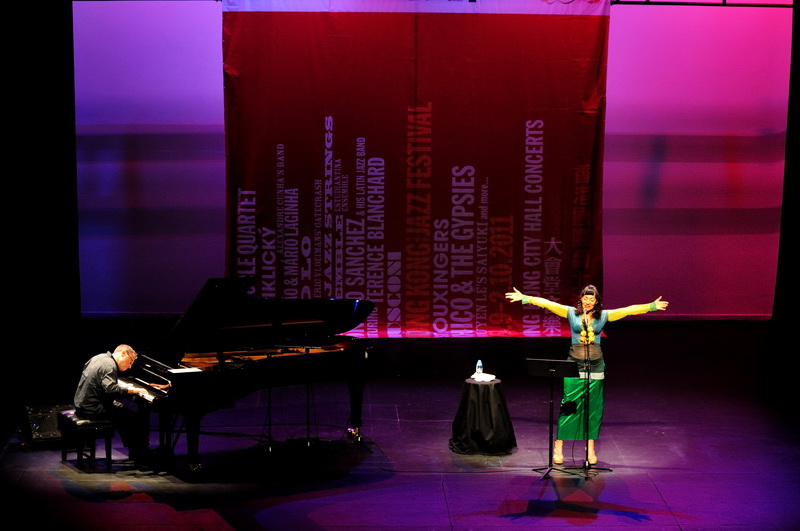 From left: Mário Laginha, Maria João
From left: Mário Laginha, Maria JoãoThe concert finished with an up-tempo African-inspired song. Laginha delivered one of his most arresting solos of the evening, eclipsed however, by João's extraordinary improvisation which sounded like a cross between a snorting bull, an African celebration and an exorcism rolled into one. A standing ovation brought the pair back onto the stage and a bluesy rendition of "I've Grown Accustomed to His Face" felt more serenade than set closer. João and Laginha's unforgettable performance was an absolute highlight of the festival, and a feather in the cap of the festival programmers.
Coming up on days 7-8 of the Hong Kong International Jazz Festival: Nguyen Le's Saiyuki; Rusconi; Siu2; Poncho Sanchez' Latin Big Band featuring Terence Blanchard; Kurt Rosenwinkel Standards Trio; Freddy Cole, and more.
Photo Credits
Page 1, Emil VIklicky Trio: Stephen Cheung
Page 1, Hong Kong at night: Paul Augustin
Page 2, Dainius Pulauskas Group: Stephen Cheung
Page 3, Emil Viklicky, Cyril Zelenak: Stephen Cheung
Page 4, In The Country: Angel Yu; Maria João, Stephen Cheung
Page 5: Maria João/Mário Laginha: Angel Yu
All other photos: Ian Patterson
Days 1-3 | Days 4-6 | Days 7-8
Tags
Hong Kong International Jazz Festival
Live Reviews
Ian Patterson
China
Beijing
Freddie Hubbard
Michel Legrand
Irving Berlin
Benny Goodman
Julie London
Dainius Pulauskas
Joe Zawinul
Flat Earth Society
Emil Viklicky
Jan Johansson
Georg Riedel
Esbjorn Svensson
Tord Gustavsen
Andreas Ulvo
Victor Verney
Bill Evans
Wynton Kelly
In the Country
Morten Qvenild
Keith Jarrett
Nik Bartsch
E.S.T.
Maria Joao
Mário Laginha
Joni Mitchell
Charles Mingus
Lester Young
nguyen le
Rusconi
SIU2
Poncho Sanchez
Terence Blanchard
Kurt Rosenwinkel
Freddy Cole
PREVIOUS / NEXT
Support All About Jazz
 All About Jazz has been a pillar of jazz since 1995, championing it as an art form and, more importantly, supporting the musicians who make it. Our enduring commitment has made "AAJ" one of the most culturally important websites of its kind, read by hundreds of thousands of fans, musicians and industry figures every month.
All About Jazz has been a pillar of jazz since 1995, championing it as an art form and, more importantly, supporting the musicians who make it. Our enduring commitment has made "AAJ" one of the most culturally important websites of its kind, read by hundreds of thousands of fans, musicians and industry figures every month.





















